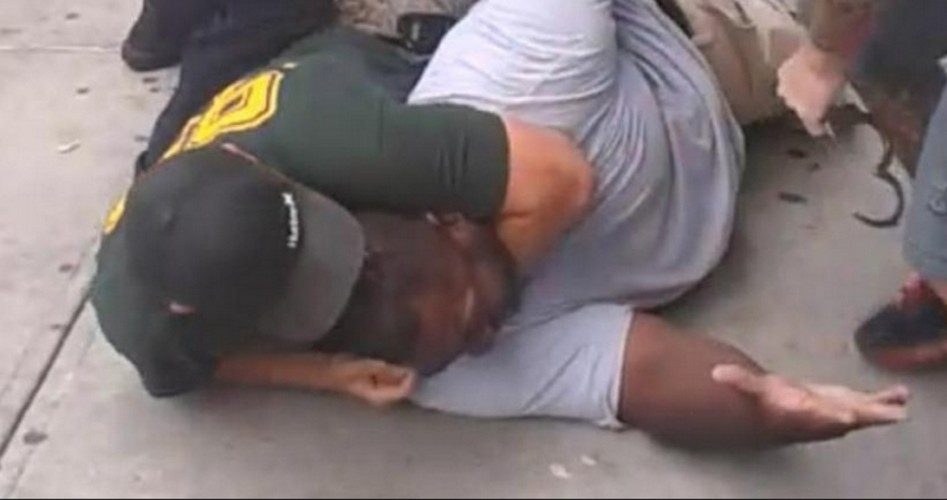
There is a racial double standard in the Eric Garner affair — one hardly anyone is talking about.
The July 17 New York City arrest incident after which the 400-pound Garner died, and which has sparked protests around the nation, was reportedly supervised by a black female commanding officer, Sergeant Kizzy Adoni. And while the focus has been on Officer Daniel Pantaleo, the white policeman who placed Garner in the much discussed choke-hold, a few are asking a question: Doesn’t the buck stop with the person in charge?
This certainly seems the point of view of another black woman, Cheryl Dorsey, a retired 20-year veteran sergeant of the Los Angeles Police Department. She says, writing at LA Progressive, “The female sergeant on scene had an affirmative responsibility to take control of the officers, the situation and thus Eric Garner. The sergeant failed.”
Of all those who believe the NYPD acted inappropriately in the Garner affair, Dorsey, interestingly, is one of the few not placing a greater onus on an underling, Pantaleo, than on the person in charge, Adoni. But another interesting fact is that there is a parallel between the Garner death and a high-profile incident involving Dorsey’s own LAPD, one occurring more than 20 years ago.
The 1991 Rodney King affair, in which King was arrested by Los Angeles police officers after a high-speed chase, shared many similarities with the Garner case. Both involved a black suspect resisting arrest. There was video of both that many thought showed the police using excessive force. Both received great media attention and tendentious coverage that sparked riots. Another commonality is that both involved a supervising sergeant who never laid a hand on the suspect.
But then there are the differences. One is that the sergeant in the LAPD incident did deploy a Taser against King (after which King nonetheless got up); another, however, is that King lived while Garner died. Then there’s also this difference: While Sergeant Adoni was offered immunity to testify, the officer in the King affair, Sergeant Stacey Koon, was indicted. And then there’s the difference that, some say, explains this difference:
While Adoni is black, Koon was white.
American Thinker’s Jack Cashill makes this point, calling it a “serious double standard.” He strengthens his case by pointing out that the only person who faced indictment in the Garner incident was another white officer — and a subordinate at that — Pantaleo. Cashill then writes:
According to Police Benevolent Association President Pat Lynch, Pantaleo did “nothing more than take Mr. Garner into custody as instructed.” He did so using “the take-down technique that he learned in the academy.”
… Had Garner not [had] health problems — obesity, advanced diabetes, heart disease and asthma — he likely would not have been hurt. There were 228,000 misdemeanor arrests in New York City in 2013. No others ended in this fashion.
No doubt. It should be noted that the 400-pound Garner did not die on the scene, but suffered a heart attack in the ambulance en route to the hospital.
Yet such facts are secondary to the issue at hand. This isn’t just because a grand jury has refused to indict Officer Pantaleo, but because, as Harry Truman’s favorite motto tells us, “The buck stops here.” However one characterizes the treatment of Eric Garner, there are only two possibilities:
1) It was done under the orders, or with the tacit approval, of commanding officer Kizzy Adoni.
2) Adoni objected, but was unable to control her subordinates.
If number one and brutality really was an issue, then Adoni is primarily responsible and should have been the first facing indictment.
If number two was the case, then she is an incompetent leader incapable of asserting authority; this is particularly clear given the fact that (as we know from the video) she did not attempt to intervene in the police action. Moreover, if the police acted rightly, not only is she thus deficient but she also judged the situation incorrectly.
And taking the position that brutality was an issue, Cheryl Dorsey certainly seems to agree. Implying that Adoni was either guilty of a failure of commission or omission, she wrote, “I am appalled by the seeming lack of leadership displayed by the sergeant on the scene during the #ICantBreathe incident…. [F]or a sergeant, and a black woman at that, to stand idly by and do nothing is egregious.”
None of this should be construed as meaning that Adoni is at fault. If the officers acted correctly and under her orders, she was simply performing her duty. There’s no reason to indict her in print any more than the grand jury did in the courthouse. But, say critics, there is good reason to indict a system that assigns blame not based on rank, but race.
As to this, Cashill asserts that Pantaleo has good reason to feel aggrieved, writing:
Pantaleo may have a civil rights case of his own. As PBA president Lynch noted, Pantaleo took Garner into custody “as instructed.” What caused Garner such distress was not so much the take-down as the pressure three officers, Pantaleo among them, brought to bear on Garner in trying to cuff him. Health professionals call this “restraint-related positional asphyxia.”
… Pantaleo has one other major gripe. As a result of affirmative action, collective bargaining, and the Americans with Disabilities Act, the NYPD ranks are loaded with physically useless cops. Many of them were on the scene that day. At least two male officers were less than 5’ 6” and slight. Three other male officers were obese, one shockingly so, and the two female sergeants appeared to be both short and overweight. If Pantaleo had not been there, it is hard to imagine how his colleagues would have effected an arrest.
In other words, Cashill is saying that not only did racial politics place Pantaleo in the crosshairs, but racial policy-making placed him at the center of the Garner arrest in the first place by creating a situation in which he was perhaps the only competent officer on the scene.
So under our model of racial politics the buck still stops — unfortunately, it seems to stop at skin color as much as at authority.




